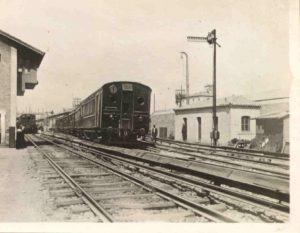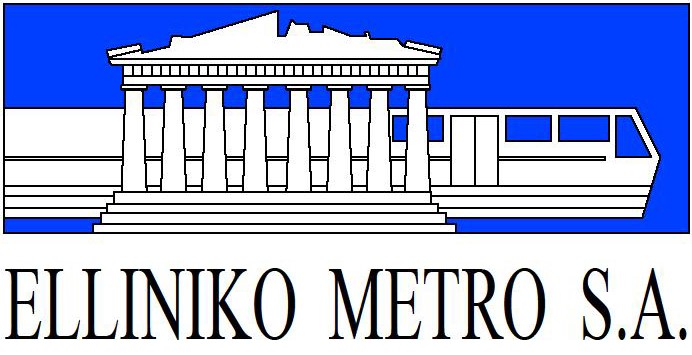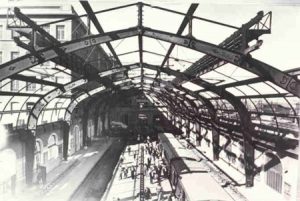At the end of World War II, as was the case in most of Europe, the public transportation system of Athens was in ruins. The central area of Athens was served by the remnants of a worn out tramway system that was sorely in need of rehabilitation or replacement. A single Metro line extended from the port of Piraeus north through Omonia Square — the heart of the central business district of Athens — to Attiki Square. Prior to the war, the Metro was connected in Attiki Square with a now-abandoned one-meter gauge steam railway with the northern suburb of Kifissia; all that was left of this line was a disused right-of-way. Bus lines and taxi services that operated before the war were virtually non-existent, most of their vehicles having been confiscated by the occupying forces or destroyed. Harking back to ancient times, walking had once again become the most common form of transportation in Athens.
Faced with this situation, the Greek Government invited interested individuals to invest in acquiring buses and, alone or with partners, provide public transportation services on lines of their choice. The owner of a bus, who very often also was its driver, was responsible for its operation and maintenance on a day-to-day basis. Entrepreneurs responded and, in those early post-war days, the investment in a bus had a high rate of return.
This “simple” style of operating could not and did not last very long. As people flocked to Athens looking for better employment opportunities than those that existed in their villages, the demand for public transportation services started to increase sharply. So did the squabbles among the bus owner-operators, each one of whom wanted to see his bus running in one of the lucrative high demand corridors and, in particular, on a route where the topography resulted in the lowest possible fuel consumption and the least “fatigue” on the vehicle in order to minimise operating and maintenance costs.
The problems associated with unrestricted free enterprise led to the formation of the “KTEL” system for managing and coordinating bus services. This acronym is made up of the initials of the words in the Greek language for “Common Treasury for Buses.” The system was somewhat more complicated than implied by its name, but it addressed the problems of the past rather successfully. Now everybody’s buses were scheduled by the Operating Office of the KTEL which was responsible for rotating them from line to line so that over a cycle period each owner-operator had an equal share of the fare revenue and each bus would be exposed to all road conditions, good or bad, and thus had similar costs for fuel and maintenance. The KTEL system, though a little cumbersome, worked well and provided reasonable bus services in the 1950s and 1960s. In 1965, public transportation usage in Athens hit its all time height of 973 million passengers on all modes.
Other significant changes in the urban transit network occurred during this period. Electric trolley buses were introduced in Piraeus in 1949 and in Athens in 1953. By 1961, all local tram lines in Athens and Piraeus had been replaced by electric or internal combustion powered buses; suburban trams connecting Piraeus with Perama continued to operate until 1977 when they too were replaced by diesel buses.
In the meantime, a start was made on developing a Metro System for the Greater Athens Area. The existing line connecting Piraeus with Athens had its origins in Greece’s first steam railway, placed in service in 1869. This line was extended from Thissio through Monastiraki to Omonia in 1894, electrified and converted into one of Europe’s first metropolitan railways in 1904, and extended from Omonia through Victoria to Attiki Square in 1926. Three decades later, the Metro was extended via the right-of-way of an abandoned one-meter gauge steam railway, reaching Nea Ionia in 1956 and its present northern terminal in Kifissia in 1957. Although ambitious proposals were announced for additional Metro lines, the funds needed to construct them were not available.
Those were the days when urban transit services with a low fare structure could easily cover their operating costs and leave significant profits for their owners or operators. This was not to last much longer. While the population of the Greater Athens Area was increasing at a significant rate (3.5 percent per annum in the 1961-1971 period and 1.75 percent per annum in the 1971-1981 period), the much greater rate of increase in privately owned automobile ownership became the most significant factor affecting usage of public transportation services. In 1961, 39,000 automobiles were in circulation. By 1971 this number had grown to 170,000, representing a phenomenal rate of growth of 15.8 percent per annum. Although the growth rate declined gradually to 11.2 percent per annum in the 1972-1981 decade and to 6.7 percent in the 1982-91 decade, the number of automobiles in use in Athens increased to 492,000 in 1981 and to 943,000 in 1991. In addition, over 16,000 taxis had been licensed by 1991.
The very high ownership and usage of automobiles and taxis had a significant depressing effect on the ridership of urban transit services. Public transportation trips per year dropped from the record figure of 973 million passengers in 1965 to a spiralling 510 million passengers in 1983. The attendant loss of revenue, coupled with spiralling operating costs, made urban transit services unprofitable.
| YEAR | MILESTONES |
| 1869 | Commissioning of the first steam-driven railway of Greece (Piraeus–Thissio) |
| 1894 | Extension of the railway network (Thissio–Omonia) |
| 1904 | Electrification of the railway network |
| 1949 | First electrical buses in Piraeus |
| 1953 | First electrical buses in Athens |
| 1957 | Extension of the railway network to Kifissia (Kifissia Station) |
| 1971 | ILPAP public company replaces the private company of Electrical Transports |
| 1976 | ISAP private company replaces EHS private company |
| 1978 | Establishment of Athens Urban Transport Organization |
| 1991 | Establishment of ATTIKO METRO S.A. |
Recognising the importance to the public welfare of public transportation services, the Government began to supplement the revenues collected by the operators with subsidies to offset their losses. Concerned about the decreasing level and quality of service being provided by the urban transit system, the Government made several attempts to reorganise it. After considerable study and debate, the following major changes in its organisational structure took place in the 1970s:
- The private-owned Electric Transport Company, operator of the trolley bus lines in Athens and Piraeus, was dissolved in 1971 and replaced by the Government-owned Athens – Piraeus and Suburbs Electric Bus Company
- The privately-owned Hellenic Electric Railway Company, operator of the Metro line and the Piraeus – Perama tram line, was dissolved in 1976 and replaced by the Government-owned Athens – Piraeus Electric Railway
- The diesel bus lines operated by the Common Treasury for Buses were taken over by the Government-owned Urban Transport Company in 1978
 Recognising the need for proper planning, programming and budgeting of urban transit services, the Government established the Urban Transport Organisation in 1978 as an independent publicly-owned company with the mandate to co-ordinate and support the three operating companies.
Recognising the need for proper planning, programming and budgeting of urban transit services, the Government established the Urban Transport Organisation in 1978 as an independent publicly-owned company with the mandate to co-ordinate and support the three operating companies.
In summer 1991 based on Law 1955 ATTIKO METRO S.A.was established. Its scope is the design, construction, organization, administration, operation, running and development of the Metro network in the area of Attica Prefecture and, thus, at the end of 1992 the construction of two new Metro Lines initiated.
At the end of 1993 the Societe Anonyme entitled “Organization of Urban Transport of Athens (O.A.S.A S.A.)” was established as a Legal Entity of Private Law; O.A.S.A. became the general successor of O.A.S. along with its responsibilities. In 1996, O.A.S.A. statutes were amended and are adapted to the provisions of Law 2414 about the modernization of the Urban Transport.
As of December 1998, along with the publication of Law 2669, the Athens – Piraeus Urban Transport have entered a new phase. The planning, programming, organization, coordination, control and the Transport related services offered by all Transportation Modes belong to O.A.S.A, while the transport services, through buses, trolley-buses, electrical railway in the area of O.A.S.A.’s responsibilities, are provided by the Executive Agencies of Transport Services (E.THE.L. S.A., I.L.P.A.P. S.A., I.S.A.P. S.A.), which are contracted with O.A.S.A. and constitute its subsidiaries.
In the meantime, the construction of Lines 2 and 3 of the Athens Metro has progressed smoothly and in January 2000 the first section of the Project” Line 2 “Syntagma – Sepolia” and Line 3 “Ethniki Amyna – Syntagma”, 13km long with 14 Stations, was commissioned.
In November 2000, Line 2 section SYNTAGMA-DAFNI, 5km long with 5 new Stations, is added to the network, while in the same year the Company “ATTIKO METRO OPERATION COMPANY S.A. (AMEL S.A.)” is established, its purpose being the management of the system’s operation.
In April 2003, Line 3 section SYNTAGMA-MONASTIRAKI, 1.5km long with one new Station, is added to the network and in summer 2004 the first extensions are handed over:
- Line 3 (MONASTIRAKI-ETHNIKI AMYNA) is extended below the surface to the north (by 5.9 km) up to DOYKISSIS PLAKENTIAS Station, where the new Metro trains emerge to the surface and through the Lines of the Suburban Railway reach the Station of the International Athens Airport “Eleftherios Venizelos”.
- Line 2 (SEPOLIA-DAFNI) is extended on either side and the Metro network now reaches AGIOS ANTONIOS (Peristeri) Station to the west and AGIOS DIMITRIOS/ALEKOS PANAGOULIS Station to the south.
In May 2007, the Metro Line 3 Extension from MONASTIRAKI to EGALEO was integrated in the Metro network. This 4.2 km long extension, comprising 3 new modern stations, improved to a great extent the transportation of the residents of western suburbs. In December 2013, a new Metro Line 3 extension from EGALEO to AG. MARINA (Municipality of Aghia Varvara) was also commissioned. This 1.4km long extension serves on a daily basis more than 30,000 passengers. Upon delivery of AGHIA MARINA Station to the public, a total of 7 stations had been commissioned in 2013, namely PERISTERI and ANTHOUPOLI Stations on April 5th 2013, ILIOUPOLI, ALIMOS, ARGYROUPOLI and ELLINIKO Stations on July 25th 2013.
Nowadays, the two Lines of the Athens Metro are 59.7 km long in total (including 20.7 km of suburban railway line from Doukissis Plakentias to the Airport) with 40 modern Stations (including 4 stations in common use with the Suburban Railway). Metro Lines 2 and 3 serve approximately 938,000 passengers on a daily basis, while Line 1 of ISAP (25.6km long with 24 Stations) serves 460,000 passengers. The citizens of Athens are now in the position to perform “combined trips”, thus, saving valuable time in their every day transfers. It takes only 14 minutes to the Metro users to cover the distance between Syntagma and Halandri, while the same distance is covered in 45 minutes in peak hours by using a privately owned vehicle.
The Athens Metro, one of the most important transit projects and the most popular means of transport in the Basin keeps on extending at a rapid pace.
ATTIKO METRO S.A. re-procured on November 21st 2008 the project related to the Metro extension to Piraeus. On March 1st 2012 the relevant contract was concluded between ATTIKO METRO S.A. and the Contracting Joint Venture J&P AVAX A.E., GHELLA SPA, ALSTROM TRANSPORT S.A. This extension shall be 7.6km long in total and shall add 6 new Stations to the Metro network, serving both the western suburbs of the Athens Basin and the areas of Piraeus, which will have 3 modern Metro Stations.
In view of serving the public transport needs, a huge number of new buses driven by natural gas and/or diesel is already in operation, while the gradual replacement of the entire fleet is scheduled.
In brief, the entire Transit System in Athens is being transformed aiming at serving as many areas of the Athens Basin as possible. The benefits to derive from the systematic use of the public transportation means are numerous for those using the aforementioned means (speed, comfort, safety, reliability), as well as for the every day life of the citizens in general (air pollution decrease, mitigation of noise, etc.).
To this end, the Societe Anonyme entitled STATHERES SYGKOINONIES ANONYMI ETAIREIA (trademark: STASY) was established in 2011, following the absorption of the companies ISAP A.E. and TRAM A.E. by AMEL A.E.. STASY forms part of OASA group of companies and its main scope of works in the execution of the public transport work within the boundaries of Attica Prefecture through the (surface and underground) fixed route modes (i.e. urban railways, tramways and other fixed track modes).



